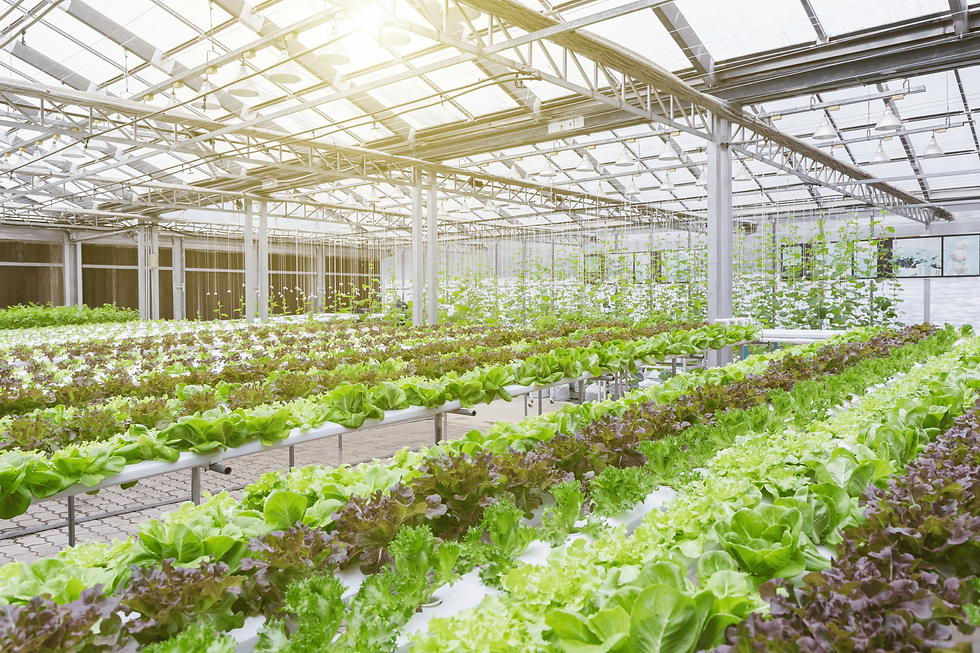The Future of Hydroponic Farming in India
- Agricor
- Feb 14
- 3 min read
Updated: Feb 23

The Farming community holds the belief that staple crops and vegetables require fertile soil, abundant water, and ample sunlight to thrive. Traditionally, the Indian farming community has believed that staple crops and vegetables cannot be grown successfully without good soil, ample water, and plenty of sunlight. While this mindset has dominated agriculture for centuries, global farming trends are evolving, and India stands to benefit from this shift.
Hydroponic farming, an innovative technique that doesn't require soil, is gaining traction in India. Instead of relying on natural sunlight, hydroponics uses artificial light in a spectrum of blue, red, and yellow to help plants grow. Modern agricultural practices emphasize that plants need water, nutrients, and high-quality seeds, and with hydroponics, soil is no longer a necessity.
Early Stages of Hydroponic Farming in India
Hydroponics is still in its early stages in India. The country’s agricultural practices have traditionally been soil-dependent, and most of the current hydroponic farms are located in urban areas, particularly in Tier 1 cities. While these farms are largely experimental and often focus on growing microgreens, the idea of scaling up to full-scale production of staple crops like wheat, barley, and rice remains a distant goal.
The cost of setting up hydroponic farming systems is high, which makes growing vegetables more expensive. However, as demand for fresh produce increases, many forward-thinking farmers are starting to adopt hydroponics. In India, there are now over 40 commercially operational hydroponic farms, with many more in development. These farms are typically located near metropolitan areas to cater to local demand, with large-scale farms concentrated in southern and western regions like Hyderabad, Bangalore, Chennai, and cities in Maharashtra, including Mumbai, Pune, Nashik, and Kolhapur.
Rising Popularity of Hydroponics
Though still in its infancy, hydroponic farming is gaining attention. It has gained traction primarily for growing high-value, fast-growing crops like leafy greens (lettuce, arugula, pakchoi), herbs (Italian basil), and vegetables (cherry tomatoes, cucumbers, bell peppers). These crops account for the majority of hydroponic production in India, both in terms of quantity and market value.
In the future, hydroponics could become more popular as awareness increases, leading to greater competition in the market. As consumer interest in sustainable and locally-grown produce rises, this farming method will likely become more widespread.
Hydroponic Farming's Potential in New India
India’s rapidly growing population is one of the main drivers for the need to explore alternative farming methods. With arable land becoming increasingly scarce, producing enough food to feed the population will be a growing challenge. Hydroponics presents a solution to this problem, offering the potential to cultivate more crops while reducing the need for soil, land, and water.
This shift could spark a "new Green Revolution" in India, especially among millennials, who are more environmentally conscious and open to innovative farming practices. Hydroponic farms typically use less land and water than traditional farming, while also speeding up the growth of crops. These benefits could help alleviate some of the strain on India's agricultural system.
Additionally, hydroponic farming could help reduce the environmental impact of traditional farming. Because hydroponic systems are highly efficient, they require less water and space. This reduction in water usage means more water can be allocated for other purposes, contributing to better water conservation across the country.
Environmental and Economic Benefits
One of the key advantages of hydroponic farming is its ability to reduce the need for pesticides, herbicides, and insecticides. With fewer pests and weeds, the environmental impact of farming can be significantly reduced. This means cleaner land and less chemical runoff into the environment, which is a significant concern in traditional farming.
As a result, the widespread adoption of hydroponic farming could help address many of the pressing environmental issues related to agriculture. It could also play a role in improving food security by providing fresh produce in urban centers, where access to quality food can sometimes be limited.
Conclusion
While hydroponic farming in India is still in the experimental phase, its future looks promising. As technology advances and awareness grows, it has the potential to transform Indian agriculture by offering sustainable solutions to issues like limited land and water resources. If successful, hydroponics could play a pivotal role in ensuring food security, reducing environmental harm, and contributing to the country’s overall agricultural growth. The next few years will be critical in determining how quickly this innovative farming method can take root and become a mainstream practice in India.

Comments